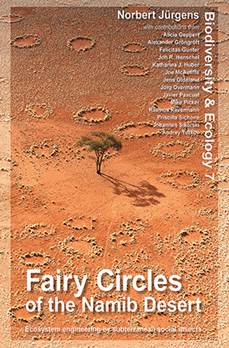
New book celebrates mysteries of the desert’s fairy circles

Dancing fairies? Poisonous euphorbias? Sneaky termites? “Clever” grasses? Who or what is causing the mysterious bare circles in the grasslands on the eastern edge of the Namib Desert?
The book “Fairy circles of the Namib desert” was published in Germany last December and is now also available in Namibian bookshops.
Prof Norbert Jürgens from the University of Hamburg has been studying the vegetation of the Namib for 43 years and has been fascinated by the mystery of the fairy circles ever since.
As of 2008, he has been systematically investigating the phenomenon, with measuring stations in fairy-circle areas from the southwest of Angola to the northwest of South Africa.
Jürgens published volume summarises fairy circle research in all its sub-areas.
On 376 pages, he and 14 other experts present the results of their in-depth studies on the morphology, ecology, and biology of fairy circles and the organisms which create, use, and maintain them. Other regular vegetation patterns of the Namib and neighbouring biomes are also introduced and discussed.
For the scientific community, the book is written in English and studded with references. For interested laypersons, it is comprehensibly worded, attractively designed, and illustrated with almost 800 photos, graphs, and tables. Breathtaking photographs invite the reader on a journey through the diversity of fairy circle landscapes in Namibia, Angola, and South Africa.
Meanwhile, on 22 March at 19h00, the main author Jürgens will give a public lecture and publisher Klaus Hess will officially present the volume at the Namibia Scientific Society.
On the following weekend, 25/26 March, Jürgens, in cooperation with Gondwana Collection Namibia, has invited the public to a “fact check excursion” to the fairy circles of the Namib.
For further details please check the website Gondwana-collection.com/promotions-namibia#fairy-circles.











































